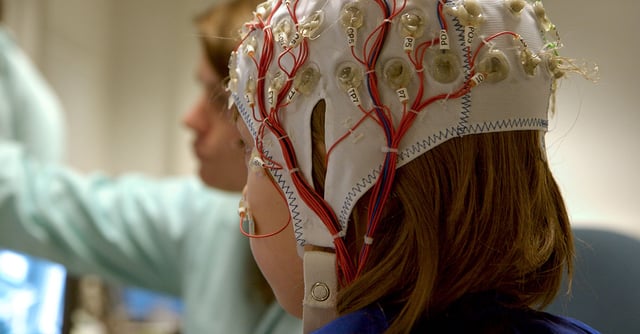
Jan 22, 2024What is epilepsy?

Back to Blog Overview
Epilepsy is a serious neurological brain disorder that causes recurring seizures and is common in children with cerebral palsy. There are many types of seizures, and they can range from mild to severe. Typically, anti-epileptic drugs are used as treatment to control seizures.
In this article you can learn more about:
- What is epilepsy and what are the symptoms?
- Different types of seizures
- What is epilepsy caused by?
- Why do people with CP often have epilepsy?
- How is epilepsy treated?
What is epilepsy and what are the symptoms?
Epilepsy is a serious neurological brain disorder that causes recurring seizures. In the US 1 in 26 develop epilepsy in their lifetime. Epilepsy means “seizure disorder”.
Symptoms of epilepsy is a seizure. This is a temporary burst of electrical activity in the brain which either change or disrupt messages sent between the cells in the brain. A seizure typically last from a few seconds to several minutes. When you have a seizure, this can cause different symptoms such as involuntary body movements (Ex. Jerking, shaking, stiffness), changes in sensation, behaviour or awareness. If you experience an event of seizure, it does not necessary mean that you have epilepsy. Seizures can also occur due to a physical cause such as acute medical illness, metabolic cause, fever, trauma or stroke. These are often called “provoked seizures”.
If you have a seizure you will need to see your General Practitioner (GP) who in most cases will refer you for assessment with a neurologist. The specialist will gather information from you to understand more about the situation. It can be questions such as:
- When did the seizure occur?
- What where you doing when it occurred?
- Do you remember what you were feeling just before it happened, during and afterwards?
The neurologist will also conduct scan called electroencephalogram (EEG). It is a pain free test where sensors are attached to the scalp picking up signals produced by the brain.
Different types of seizures
There are different types of seizures, but most people will only have one type. During the assessment the specialist will define what type you have as this influences type of treatment.
Types of seizures:
- Focal seizures
- Generalised seizures
Focal seizures are only affecting one part of your brain, and this means the symptoms will differ depending on where in the brain the seizure occur. Symptoms may be:
- Awareness of what is going on
- Muscle stiffness in limbs or face
- Unusual sensation (smell, vision)
- In some cases, you might get a warning sign before the seizure occurs. It can be loss of awareness or restlessness.
Generalised seizures are affecting your whole brain and often you will experience black out. Symptoms that may be caused
Motor symptoms
- Rhythmical jerking movements
- Muscles weakness or stiffness
- Brief muscle twitching
- Epileptic spasm, where limbs flexes and extends repeatedly
Non-motor symptoms
- Often described as “absent seizures” as you are staring blankly into space and are not aware of your surroundings.
What is epilepsy caused by?
For some people it is uncertain what is the cause of epilepsy and for others the doctor can trace epilepsy directly to:
- Brain trauma (stroke, tumour, injury, drug abuse)
- Metabolic issues
- Infections
- Autoimmune disease
- Genetics
Why do children with CP often have epilepsy?
Children with CP have higher risk of getting epilepsy compared to people without CP. The reason is that CP is caused by a brain injury, and brain injuries increase the chance of abnormal nerve activity in the brain. It is indicated that around 30-40% of children with CP will experience co-occurring seizures. The frequency of epilepsy is higher in children with CP who have severer motor dysfunction (GMFCS level IV-V).
How is epilepsy treated?
Type of treatment is depending on the results from the neurological assessment, but in most cases anti-epileptic drugs (AEDs) are tried. In 7 out of 10 people AEDs help to control seizures. The medication changes the levels of chemicals in your brain, but do not cure epilepsy. Different types of drugs can be tested if you do not have the expected effect.
Other treatments can be considered if anti-epileptic drugs are not working. This can be:
Brain surgery where part of your brain is removed. This is only possible if the seizures are caused by a problem in a small part of your brain and there is low risk of causing serious effects.
Vagus nerve stimulation (VNS) is a small electrical device placed under your skin at your chest. A wire connects the electrical device with the vagus nerve in your neck and sends burst of electricity to the nerve. This can in some cases control the seizures.
Ketogenic diet with low carbs and high fat can be tried in cases where children do not respond to anti-epileptic medications. This diet is mainly used in children. The high fat diet is normally not recommended for adults due to risk of serious health conditions such as diabetes and cardiovascular diseases.
Referances:

Rikke Damkjær Moen brings many years of experience as clinical physiotherapist to the Made for Movement team. Her mission is to ensure that everybody, regardless of mobility problems, should be able to experience the joy and health benefits of physical activity. As our Medical Manager, Rikke is passionate about sharing knowledge so that individuals with special needs, families, and clinicians can discover the possibilities and solutions provided by Made for Movement.


